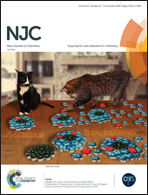Biocarbon-templated synthesis of porous Ni–Co-O nanocomposites for room-temperature NH3 sensors†
Abstract
In this study, a mesoporous biocarbon material (BCM) with connected pore channels and a large specific surface area (525.83 m2 g−1) was prepared by a carbonization approach with inexpensive hemp stem as the raw material. The BCM was used as a template to fabricate porous nickel–cobalt oxide (Ni–Co-O) nanocomposite structures in situ. The composition of the Ni–Co-O nanocomposites was readily controlled by adjusting the Co-to-Ni ratio of the initial nickel and cobalt nitrates. Furthermore, we constructed porous Ni–Co-O nanocomposite-based sensors. The room-temperature (RT) NH3 sensing results indicated that the sensor with the best performance exhibited a high response of 3 to 100 ppm, a low detection limit of 50 ppb, good stability (higher than 7 weeks), and excellent reversibility and selectivity. Therefore, the Ni–Co-O nanocomposite, featuring a large specific surface area and meso/micropore distributions, is a strong candidate as a key material for the fabrication of RT NH3 detection sensors.



 Please wait while we load your content...
Please wait while we load your content...